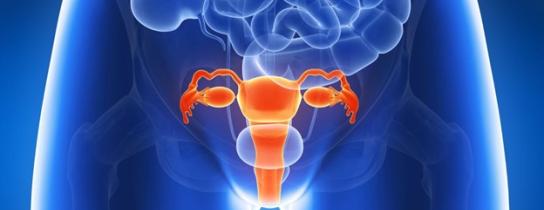
Prolapsed Uterus After Childbirth: What You Need to Know
A prolapsed uterus is a pelvic floor disorder that commonly occurs in women, particularly after childbirth. The physical stress and strain of pregnancy and childbirth can weaken or damage the muscles and tissues of the pelvic floor, especially in women who have had multiple children.1
This article explores uterine prolapse with insights from the Crystal Run Healthcare OB/GYN team. It covers what causes uterine prolapse, the symptoms to look out for, and the different treatment options available.
What Is a Prolapsed Uterus?
A prolapsed uterus occurs when the uterus herniates (falls) into the vaginal canal. There are many causes for this condition, but it is often the direct result of the physical stress and strain of pregnancy and childbirth, which weaken or damage the muscles and tissues of the pelvic floor. This leads to the uterus dropping into the vagina.2
Women experiencing this condition may feel vaginal pressure, a sensation of heaviness, or even describe the feeling as if their uterus is “falling out” after pregnancy. If you have suffered a prolapse after birth or from other causes, treatment is available to relieve this condition. Your medical provider can advise you as to whether surgical or non-surgical treatment is best.1,3
What Is the Pelvic Floor?
 The pelvic floor is a group of muscles and connective tissue that keeps your pelvic organs—uterus, vagina, bladder, urethra, and bowel—firmly in place.3
The pelvic floor is a group of muscles and connective tissue that keeps your pelvic organs—uterus, vagina, bladder, urethra, and bowel—firmly in place.3
If you’ve given birth and you notice that you lose a drop or two of urine when you laugh, cough, sneeze, or exercise, you’re not alone. This is a common condition known as stress urinary incontinence, and it can happen when the pelvic floor muscles become weakened.4
This weakening occurs when the muscles and tissues supporting the pelvic organs become damaged, reducing their ability to provide support. As a result, organs such as the bladder, uterus, or rectum can shift out of place. In the case of a prolapsed uterus, the organ can begin to drop into the vagina. In addition to stress urinary incontinence, the weakening of the pelvic floor also can lead to several other problems, including fecal incontinence.5
When one or more pelvic organs drop from their normal position, it is called pelvic organ prolapse (POP). POP affects one out of four women in their 40s, one out of three in their 60s, and half of women in their 80s. A uterine prolapse is a type of POP.6
A uterine prolapse isn’t considered a life-threatening condition, although it can have a negative impact on quality of life.2
Causes of Prolapsed Uterus
Women who have had multiple vaginal childbirths, or who have given birth to a child weighing more than 8.5 pounds, are at significantly heightened risk of experiencing uterine prolapse or another type of POP.1
Childbirth is the most common cause of uterine prolapse, but the condition can be triggered by other causes as well, such as:1,2
- Loss of estrogen (due to menopause and aging)
- Repeated heavy lifting
- Conditions creating pressure on the abdomen, such as:
- Being overweight (BMI >25)
- Constipation and straining during bowel movements
- Chronic coughing from smoking, asthma, or other medical conditions
Connective tissue disorder (e.g., Marfan syndrome)
Although this condition can develop at any age, it is most common among postmenopausal women.7 Women with a family history of POP have a heightened risk of developing this disorder.1
Symptoms of Prolapse
In some cases, a prolapse causes no noticeable symptoms at all, or symptoms that emerge only gradually. Those who do experience symptoms may have:3,7
- A feeling of fullness, pressure, or bulging in the pelvis
- Feeling that something is falling out of the vagina
- Difficulty with urination
- Difficulty with tampons
- Chronic constipation
- Lower back pain
Urinary incontinence
Sufferers of POP often report that symptoms worsen after physical activity, or at certain times of the day.1
Diagnosis of Prolapsed Uterus
To diagnose a prolapsed uterus, an OB/GYN will perform a pelvic and rectal exam and analyze the patient’s medical history. The exam can be done standing or lying down. The doctor may also include a test for urinary incontinence.7
After the examination, the provider will assign a stage to the prolapse, which will guide further discussion and treatment options.
Stages of Prolapsed Uterus
The Pelvic Organ Prolapse Quantification (POP-Q) system assesses the extent of pelvic organ prolapse by measuring the location of the farthest point of the prolapsed organ that extends or descends into the vaginal canal relative to the hymen, a thin tissue membrane located just inside the opening of the vagina. Prolapse is categorized in stages, from 0 to 4:2
- Stage 0: No observable prolapse.
- Stage 1: The lowest part of the prolapsed organ is more than 1 cm above the level of the hymen.
- Stage 2: The lowest part of the prolapsed organ is within 1 cm above or below the hymen.
- Stage 3: The lowest part of the prolapsed organ extends more than 1 cm below the hymen but remains less than 2 cm from the total vaginal length.
Stage 4: Complete eversion of the vagina, meaning it is turned inside out and protrudes outside the body.
Treatments for Prolapsed Uterus
 In many cases, no treatment is necessary.7 If symptoms are severe, however, non-surgical or surgical treatments can be viable options.
In many cases, no treatment is necessary.7 If symptoms are severe, however, non-surgical or surgical treatments can be viable options.
Non-surgical treatment options for prolapse include:
Pelvic Floor Exercises
Pelvic floor exercises, commonly known as Kegel exercises, are a primary non-surgical treatment option for managing prolapse. These exercises involve the regular contraction and relaxation of the pelvic floor muscles to strengthen them. By enhancing the support provided by these muscles, it’s possible to slow the progression of the prolapse. These exercises should be done under the guidance of a physical therapist (PT) to ensure the correct technique is followed.7Pessary
A pessary is a medical device that is inserted into the vagina to provide support to the pelvic organs. These devices come in various shapes and sizes to fit individual needs and anatomical differences; one common option is the Gellhorn pessary, used in advanced cases (stage 3 or 4) of prolapse. They help to hold the organs in place, preventing them from descending further into the vaginal canal. Pessaries can be used temporarily or long-term and must be fitted by a healthcare provider to ensure effectiveness. About two-thirds of women with symptomatic POP elect pessary treatment.8,9
Surgical treatments include:
Hysterectomy to remove the uterus (through the abdomen or vagina); whether this is an option will depend on the severity of prolapse, patient medical history, and whether they plan on having children in the future. There are also other considerations, including hormonal changes that can occur after a hysterectomy. A gynecologist can counsel patients on the pros and cons of a hysterectomy.10
Sacrohysteropexy, a surgical procedure that involves attaching the uterus to the sacrum (the lower part of the spine) using a synthetic mesh. This method provides strong support to the uterus, preventing it from descending into the vaginal canal.3
Colpocleisis is a noninvasive surgical option for those who do not wish to maintain coital function. This procedure involves suturing the vaginal walls together to occlude the vaginal canal and provide support for pelvic organs, making it suitable for post-hysterectomy patients. The choice of treatment should be made after thorough counseling on the potential effects, complications, and patient preferences.2
Hysteropexy is a uterine-preserving surgical procedure designed to treat uterine prolapse. It offers benefits such as decreased intraoperative blood loss, shorter operative time, and faster recovery compared to hysterectomy with prolapse repair. This procedure is suitable for patients who wish to maintain fertility or retain their uterus. However, it requires ongoing follow-up to monitor for gynecological cancers and is not recommended for patients with a history of uterine or cervical pathology.2
It is important to understand that no treatment, whether surgical or non-surgical, guarantees a complete resolution of uterine prolapse. Each patient's condition is unique, and responses to treatments can vary.7
What To Do
 Whether experiencing symptoms or not, it's important to protect the pelvic floor to ensure that mild prolapse doesn't worsen. Here are some steps to consider:
Whether experiencing symptoms or not, it's important to protect the pelvic floor to ensure that mild prolapse doesn't worsen. Here are some steps to consider:
Eat a high-fiber diet and get constipation under control. A fiber-rich diet promotes regular bowel movements and helps prevent constipation, which can strain and weaken the pelvic floor muscles. If needed, gentle vegetable laxatives or enemas can also help manage constipation.7
Do Kegel exercises. It is important to strengthen pelvic floor muscles. Here’s how to do Kegels:7
- Find the right muscles. A person can find their pelvic floor muscles by stopping the flow of urine midstream and squeezing their anal muscles.
- Get in position. Kegel exercises can be done standing up, sitting, or lying down.
- Focus. Squeeze, tightening only the pelvic floor muscles and avoiding flexing abdominal muscles, thighs, or buttocks. It is important to breathe naturally during the exercise. Hold for three seconds, then relax for three seconds.
- Repeat. Aim for 10 repetitions, three times a day. Aim at increasing the duration of your “hold” by one second each week, to a maximum of ten seconds.
Manage weight. Carrying excess weight leads to additional pelvic floor pressure—postpartum women are particularly vulnerable to this effect, which can weaken the muscles over time.7
Exercise regularly. Exercises such as yoga and Pilates can help develop core strength, reducing the risk of developing prolapse. Be sure to avoid high-impact exercises that can aggravate your condition.6
Avoid smoking. Chronic coughing can strain pelvic floor muscles, which can worsen uterine prolapse.6
Follow postpartum recovery guidelines. After childbirth, it's important to follow recovery guidelines provided by healthcare providers to allow the pelvic floor muscles to heal properly and ensure postpartum uterus health.6
See your doctor. If you’ve had one or more vaginal deliveries and you’re noticing symptoms of prolapse, whether you feel a bulging sensation in your pelvis, intercourse has become uncomfortable, or you’re having difficulty with bowel movements, it’s important to see a gynecologist right away.
The caring and experienced OBGYN doctors at Crystal Run Healthcare offer a full range of gynecological care for women of all ages, including routine exams, Pap smears, prenatal and obstetrical care, in-office procedures, and minimally invasive surgery, including laparoscopic/vaginal robotic-assisted surgeries to correct uterine or pelvic organ prolapse. Call us at 845.703.6999 to schedule an appointment at one of our several New York State locations.
Sources:
- U.S. Department of Health & Human Services, Office on Women's Health. Pelvic Organ Prolapse, Updated 2/22/2021. Pelvic Organ Prolapse | Office on Women's Health, Accessed 10/2/2024
- National Center for Biotechnology Information (NCBI). Uterine Prolapse, Updated 10/31/2022. Uterine Prolapse | StatPearls - NCBI Bookshelf, Accessed 10/2/2024
- American College of Obstetricians and Gynecologists (ACOG). Surgery for Pelvic Organ Prolapse, Updated 7/2022. Surgery for Pelvic Organ Prolapse | ACOG, Accessed 10/2/2024
- American College of Obstetricians and Gynecologists (ACOG). Surgery for Stress Urinary Incontinence, Updated 5/2023. Surgery for Stress Urinary Incontinence | ACOG, Accessed 10/2/2024
- National Institutes of Health, Eunice Kennedy Shriver National Institute of Child Health and Human Development (NICHD). About Pelvic Floor Disorders (PFDs), Updated 1/8/2020. About Pelvic Floor Disorders (PFDs) | NICHD, Accessed 10/2/2024
- American College of Obstetricians and Gynecologists (ACOG). 5 Things I Wish All Women Knew About Pelvic Organ Prolapse, Updated 2/2024. 5 Things I Wish All Women Knew About Pelvic Organ Prolapse | ACOG, Accessed 10/2/2024
- American College of Obstetricians and Gynecologists (ACOG). Pelvic Support Problems, Updated 11/2021. Pelvic Support Problems | ACOG, Accessed 10/2/2024
- American Urogynecologic Society & International Urogynecological Association. AUGS-IUGA 2022 Abstract Supplement. Retrieved from https://www.augs.org/assets/1/6/AUGS_IUGA2022_AbstractSupplement.pdf, Accessed 10/2/2024
- National Center for Biotechnology Information (NCBI). Pelvic Organ Prolapse, Updated 10/3/2022. Pelvic Organ Prolapse - StatPearls - NCBI Bookshelf, Accessed 10/2/2024
- American College of Obstetricians and Gynecologists (ACOG). Hysterectomy, Updated 9/2024. Hysterectomy | ACOG, Accessed 10/2/2024

 Optum Radiology at Crystal Run Healthcare
Optum Radiology at Crystal Run Healthcare Request medical records online
Request medical records online